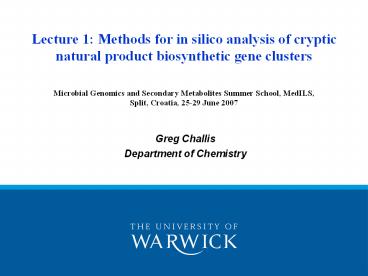Greg Challis
1 / 35
Title: Greg Challis
1
Lecture 1 Methods for in silico analysis of
cryptic natural product biosynthetic gene clusters
Microbial Genomics and Secondary Metabolites
Summer School, MedILS, Split, Croatia, 25-29 June
2007
- Greg Challis
- Department of Chemistry
2
Overview
- Introduction
- cryptic (orphan) gene clusters in microbial
genomes - Clusters encoding nonribosomal peptide
synthetases (NRPSs) - domains, modules, substrate specificity,
predicting products - Clusters encoding modular polyketide synthases
(PKSs) - domains, modules, substrate specificity,
predicting products - Clusters encoding other biosynthetic systems
- terpene synthases, iterative PKSs
3
Introduction
4
Cryptic (orphan) biosynthetic gene clusters
- Present in many of the 300 or so sequenced
microbial genomes - e.g. Streptomyces avermitilis
- Streptomyces coelicolor
- Bacillus subtilis
- Pseudomonas fluorescens
- Pseudomonas syringae
- Nostoc punctiforme
- Aspergillus nidulans
- Polyketide synthases
- Nonribosomal peptide
- synthetases
- Terpene synthases
- May prove a valuable new source of bioactive
metabolites
5
Genome sequence of the model antibiotic-producer
Streptomyces coelicolor M145
6
Gene clusters directing complex metabolite
biosynthesis in the S. coelicolor genome
Bentley et al. Nature (2002) 417, 141-147
7
Part 1 Nonribosomal peptide synthetase analysis
8
Recap of NRPS organisation and function the
gramicidin S synthetase as an example
grsA
grsB
grsT
synthetase 1
synthetase 2
module 2
module 4
module 1
module 3
module 5
A
E
C
A
A
A
C
C
C
A
TE
PCP
PCP
PCP
PCP
PCP
A Adenylation PCP peptidyl carrier protein C
Condensation E Epimerisation TE Thioesterase
9
Recap of NRPS organisation and function the
gramicidin S synthetase as an example
TE
PCP
TE
For further information see Lars Robbels poster
10
Nonribosomal peptide synthetases encoded by the
S. coelicolor genome
11
A new S. coelicolor NRPS gene cluster
cchA
cchB
cchH
cchJ
cchI
Non-ribosomal peptide synthetase (cchH)
MbtH-like protein (cchK)
Flavin-dependent monooxygenase (cchB)
Formyl-tetrahydrofolate-dependent formyl
transferase (cchA)
Esterase (cchJ)
Export functions
Ferric-siderophore import
Challis and Ravel FEMS Microbiol. Lett. (2000)
187, 111-114
12
Prediction of domain and module structure
Conserved Domain (CD) search (http//www.ncbi.nl
m.nih.gov/Structure/cdd/wrpsb.cgi)
13
Prediction of A-domain selectivity pocket residues
Stachelhaus, Mootz and Marahiel Chem. Biol.
(1999) 6, 493-505 Challis, Ravel and Townsend
Chem. Biol. (2000) 7, 211-224
14
Empirical correlation between specificity pocket
residues and substrate
Challis, Ravel and Townsend Chem. Biol. (2000) 7,
211-224
15
Prediction of substrates and possible products
for the S. coelicolor cryptic NRPS
Challis and Ravel FEMS Microbiol. Lett. (2000)
187, 111-114
16
Part 2 Modular polyketide synthase analysis
17
Recap of modular PKS organisation and function
the erythromycin synthase as an example
- Three large modular enzymes (DEBS 1-3), encoded
by eryAI, eryAII, and eryAIII, assemble 6-DEB
- Each module performs one chain extension
18
Recap of modular PKS organisation and function
the erythromycin synthase as an example
19
Recap of modular PKS organisation and function
the erythromycin synthase as an example
- Three large modular enzymes (DEBS 1-3), encoded
by eryAI, eryAII, and eryAIII, assemble 6-DEB
- Each module performs one chain extension
20
Gene clusters directing complex metabolite
biosynthesis in the S. coelicolor genome
Bentley et al. Nature (2002) 417, 141-147
21
A new S. coelicolor modular PKS cluster
Genes encoding a modular PKS
22
Prediction of domain and modules in CpkA
Conserved Domain (CD) search (http//www.ncbi.nl
m.nih.gov/Structure/cdd/wrpsb.cgi)
23
Prediction of domain and modules in CpkB
24
Prediction of domain and modules in CpkC
25
Prediction of domains and modules in CpkABC
Pawlik, Kotowska, Chater, Kuczek and Takano Arch.
Microbiol. (2007) 187, 87-99
26
Prediction of AT domain substrate selectivity
Haydock et al. FEBS Lett. (1995) 374,
246-248 Banskota et al. J. Antibiot. (2006) 59,
168-176
27
Prediction of KR domain stereoselectivity
28
Prediction of KR domain stereoselectivity
Caffrey ChemBioChem (2003) 4, 654-657 Reid et al.
Biochemistry (2003) 42, 72-79
29
Prediction of substrates and possible products
for the S. coelicolor cryptic PKS
30
Non-linear enzymatic logic can complicate things!
Haynes and Challis, Curr. Op. Drug Discov.
Develop. (2007) 10, 203-218
31
Non-linear enzymatic logic can complicate things!
Haynes and Challis, Curr. Op. Drug Discov.
Develop. (2007) 10, 203-218
32
Part 3 Analysis of other biosynthetic systems
33
Terpene synthases
34
Iterative polyketide synthases type III PKSs
35
Conclusions
- Reasonably confident in silico predictions of
domain / module organisation and substrate
specificity of modular PKS / NRPS can be made - Non-linear enzymatic logic can complicate the
reliable prediction of product structure(s) - For other types of biosynthetic system,
reasonably confident predictions of substrate
specificity can sometimes be made - Prediction of chain length and substrate
specificity in some iterative PKS systems,
especially type III and fungal type I, remains
difficult




























![⚡[PDF]✔ Greg Williams Photo Breakdowns: The Stories Behind 100 Portraits](https://s3.amazonaws.com/images.powershow.com/10062873.th0.jpg?_=20240624073)


